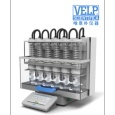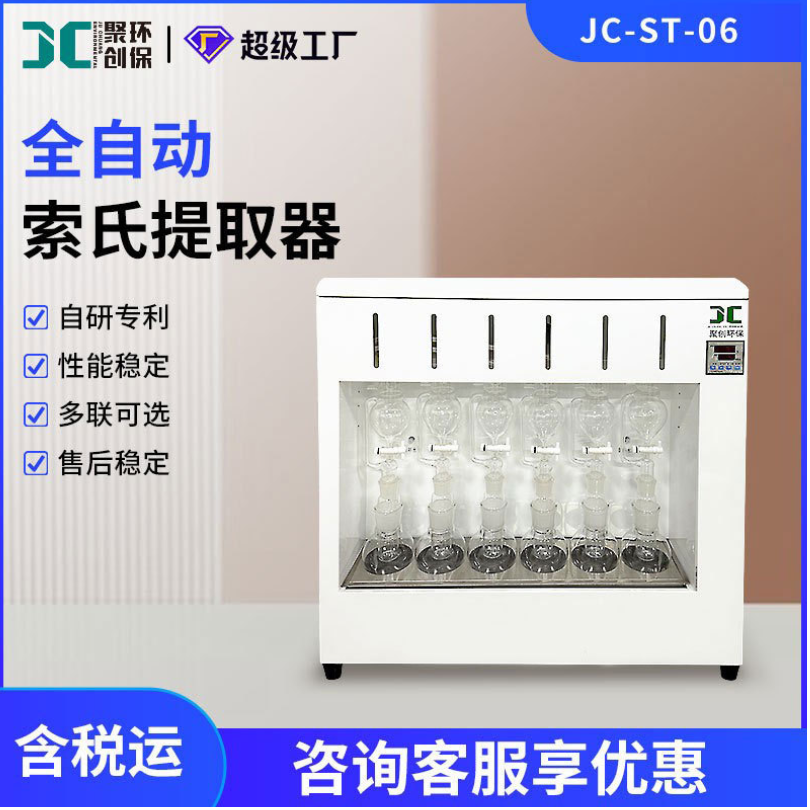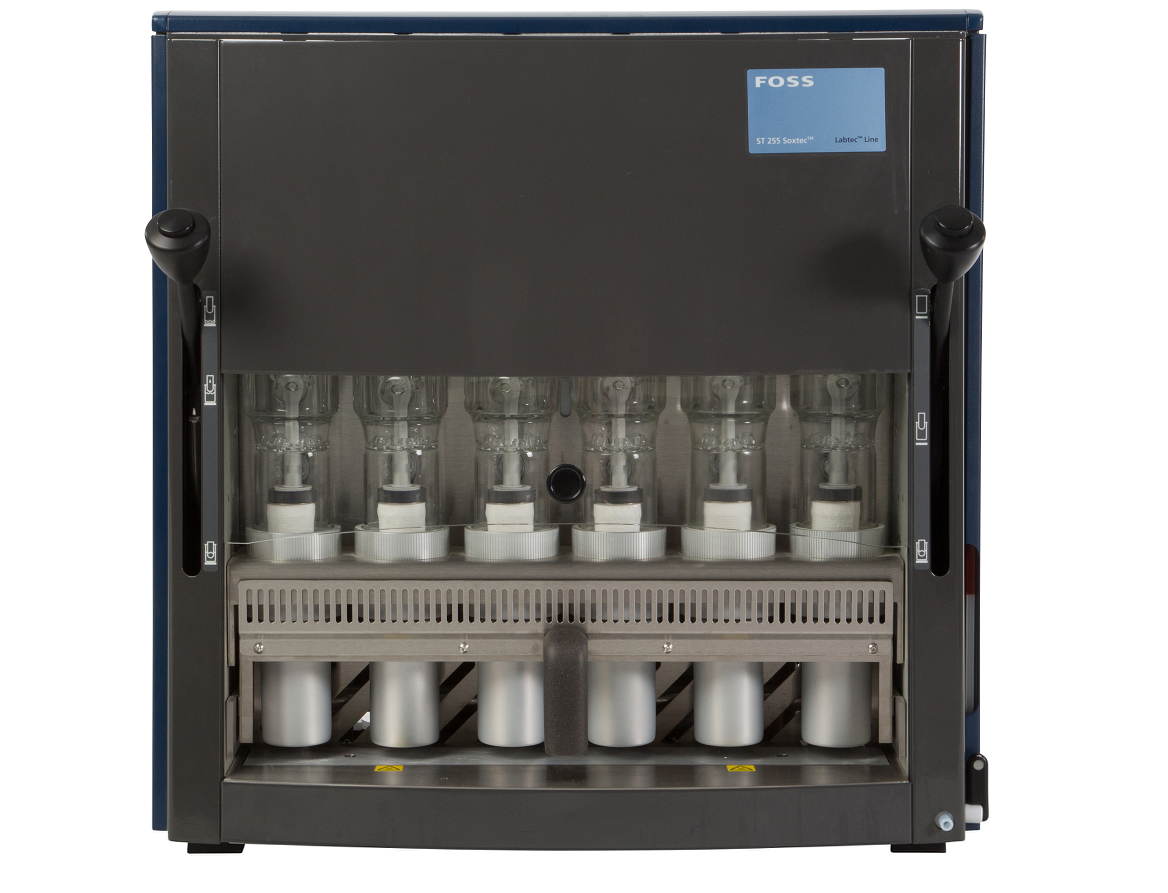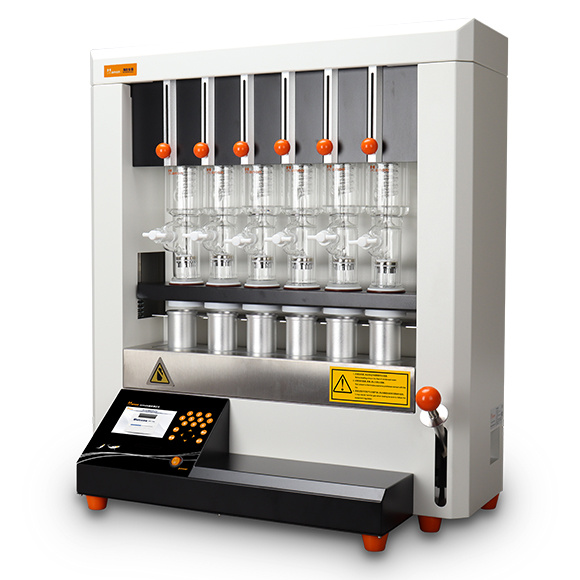
方案详情
文
1,水解过程自动化
2,全自动总脂肪测定
3,溶剂添加可实现自动化,无需放置通风橱内
4,溶剂回收率高达90%以上
方案详情

APPLICATION NOTEF&F-S-005-2016/A1 TOTAL FAT DETERMINATION IN CONDENSED MILKRANDALL METHOD Total Fat Determination inCondensed Milkaccording to the Randall method Reference: AOAC 933.05 Fat in Cheese Tested with VELP Scientifica SER 158/6 Solvent AutoExtractor (Code S303A0380) and HU6 Hydrolysis Unit(Code F30300110) Introduction Condensed milk is cow's milk from which water has been removed. It is most often found in the form of sweetenedcondensed milk (SCM), with sugar added. Sweetened condensed milk is a very thick, sweet product which when cannedcan last for years without refrigeration if unopened. The production of condensed milk is obtained starting from raw milk that is clarified and standardized and is then heatedto 85-90 °C for several seconds. This heating process destroys some microorganisms, decreases fat separation andinhibits oxidation. Some water is evaporated from the milk and sugar is added until a 9:11 (nearly half) ratio of sugar to(evaporated) milk is reached. The sugar extends the shelf life of sweetened condensed milk.Nowadays condensed milk is used in numerous dessert dishes in many countries all over the world. Fat Determination in Condensed milk Hot solvent extraction process with SER 158 Series can be summed up in 5 steps, for a fully automatic process completelyunattended: During IMMERSION the sample is immersed in boiling solvent. Then the REMOVING step automatically lowers the levelof the solvent to below the extraction thimble.During WASHING the condensed solvent flows over the sample and throughthe thimble to complete the extraction process. The fourth step involves solvent RECOVERY. Approximately 90% of thesolvent used is collected in the internal recovery tank. The final step is the COOLING of the extraction cups containing theextracted matter. The cups are raised to prevent burning. The extraction cups containing the extract are placed in a dryingoven, cooled in a desiccator and weighed for the extract percentage calculation. Sample Condensed milk Fat labeled content: 8 % In order to determine the total fat in food and feed samples a direct extraction with solvents is not efficient because a partof lipids is chemically bonded with other components. The determination of the total fat content of these samples, requiresa preliminary hydrolysis using hydrochloric acid 4 N, followed by filtration and washing, in order to free completely the fatmolecules. Then the hydrolyzed sample is ready for the extraction and it can be easily transferred to SER 158 SolventAutoExtractor avoiding any possible sample loss and ensuring improved accuracy of results (see the following picture). Chemicals and Equipment Required .Analytical balance, min. 3 decimalsTest tube 250 ml (Code A000000144). Glass sand, 0.4-0.8 mm (Code A00000089)Glass bottle for waste collector (Code A0000088)· Celite 545 (Code A00000097). Glass extraction cups (Code A00000290)。 Glass crucibles P1 (Code A00000086)\Viton sealse Hydrochloric acid 4NoPPetroleum Ether 40-60°C as solvent All the accessories required for the hydrolysis are included in the kit code A00000085. Sample Preparation ●HHydrolysis Crucibles Preparation Put 25 g of glass sand in glass crucibles P1 and 3g of Celite 545: the two layers resulting have not be mixed togetherotherwise the phase in Celite may bypass the crucible negatively affecting the end result. · Sample Preparation in Test Tube Mix the sample with a spoon and weigh 5 g of homogenized sample (Msample) and 2 g of Celite 545 in the test tube. In eachtest tube add 50 ml of 4N hydrochloric acid, shake gently and carefully, and finally add a further 50 ml hydrochloric acidin order to rinse the sample residue that may remain on the walls of the test tube. ●· Glass Extraction Cups Preparation Keep the empty glass extraction cups in oven at 105 °℃ for 1 hour. Cool them in a desiccator and record the accurateweight of the tare (Mtare). Hydrolysis Procedure with HU 6 Place 6 crucibles P1 on the HU6 and connect the aspirating tubes: one side needs to be placed on the sealing ring ofthe crucible and the other one has to be in contact with the corresponding test tube. Set 170 °C for 60 minutes. Place the 6 test tubes in the heating block, lower the glassware and activate the vacuum pump. In case of foam, add 4 N hydrochloric acid drop by drop inside the test tubes. At the end of the procedure, switch off and allow aspiration of the content of the test tubes in the crucible.Raise the glassware to its maximum point and secure it, by tightening the knob. Then, add hot water (40-50°C, about 250 ml) slowly, in order to aspirate all the residues of hydrolysis in the test tubes.Remove the aspirating tubes and the crucibles containing the sample after the washing: mix the layer of hydrolyzed sample with the layer of Celite by using a spatula in order to break any clot. Take care to not damage the layer of glass sand. This operation helps the sample drying, which must take place in an oven at 105 °C for a time between 1.5 to 6 hours. lf dried test portions will not be immediately extracted, put them in a desiccator, or let the crucibles cool to roomtemperature and then, mix the layer of hydrolyzed sample and Celite with a spatula to obtain a powdery hydrolyzed. Take care not damage the layer of glass sand. Extraction Procedure with SER 158 Fix the crucibles with the crucible holders (Code A00000293). The extraction cups containing the crucibles can now beplaced on the ultra-fast heating plate of SER 158. On the ControlPad select “Analysis”, and then method"Total fat in condensed milk”including the following parameters: ●· Immersion Time: 60 minutesRecovery Time 30 minutes.RRemoving Time: 10 minutesCooling Time: 5 minutesV● . Washing Time: 50 minutes Petroleum Ether 40-60°C, 100 ml Close the safety guard and add the solvent using the automatic solvent dispensing system SolventXpress TM to minimizeexposure to the solvent ensuring operator safety.Press START to begin the extraction process. At the end of analysis position the extraction cups containing the extract ina drying oven (1 hour at 105°C), cool them in a desiccator to room temperature and record the accurate weight (Mtot). Typical Results on Condensed milk Analysis results are calculated automatically and stored in the ControlPad when entering the weights into the software(manually or automatically through a balance). The extract percentage calculation is performed by using the followingformulas: Where: Sample= sample weight (g) Tare= weight of the empty extraction cup (g) Total= weight of the extraction cup + extract (g) Tare (g) Sample (g) Total (g) Extract (g) Extract (%) 130.4428 4.983 130.8206 0.3778 7.58 131.0601 5.101 131.4605 0.4004 7.85 130.0668 5.258 130.4664 0.3996 7.60 130.4763 5.116 130.8666 0.3903 7.63 128.8978 5.332 129.3046 0.4068 7.63 132.0689 5.868 132.5112 0.4423 7.54 Average± SD% 7.60±0.04 RSD%** 0.50 Fat Labeled content: 8 % Fat Labeled content: 8 % ** RSD% =(Standard Deviation x100)/ Average Conclusion The results obtained are reliable and reproducible in accordance with the expected values, with a low relative standarddeviation (RSD<1%), that means high repeatability of the results. Therefore, SER 158 Solvent AutoExtractor and HU6 hydrolyses unit are ideal for the fat content determination incondensed milk. Benefits of HU 6 Hydrolysis Unit are: -safety with performance, reducing manual handling to the minimum -no sample transfer required when passing from HU 6 to SER 158 -suitable for both acid and basic hydrolysis Benefits of hot solvent extraction (Randall) by using SER 158 Solvent AutoExtractor: -up to 5 times faster than Soxhlet (hot solvent vs. cold solvent) -low solvent consumption (high solvent recovery, approximately 90%)-limited cost per analysis -no exposure to solvent -worldwide official method -full traceability with automatic result calculation and on-board archive Copyright C VELP Scientifica. All rights reserved.No part of this publication may be reproduced or transmitted in any form or for any purpose without the express permission of VELP.VELP Scientifica, Italy Tel: + Fax: + www.velp.com 利用Randall方法进行总脂肪测定全自动脂肪提取通过五个步骤完成: 浸提,移除,洗涤,回收和冷却。
确定
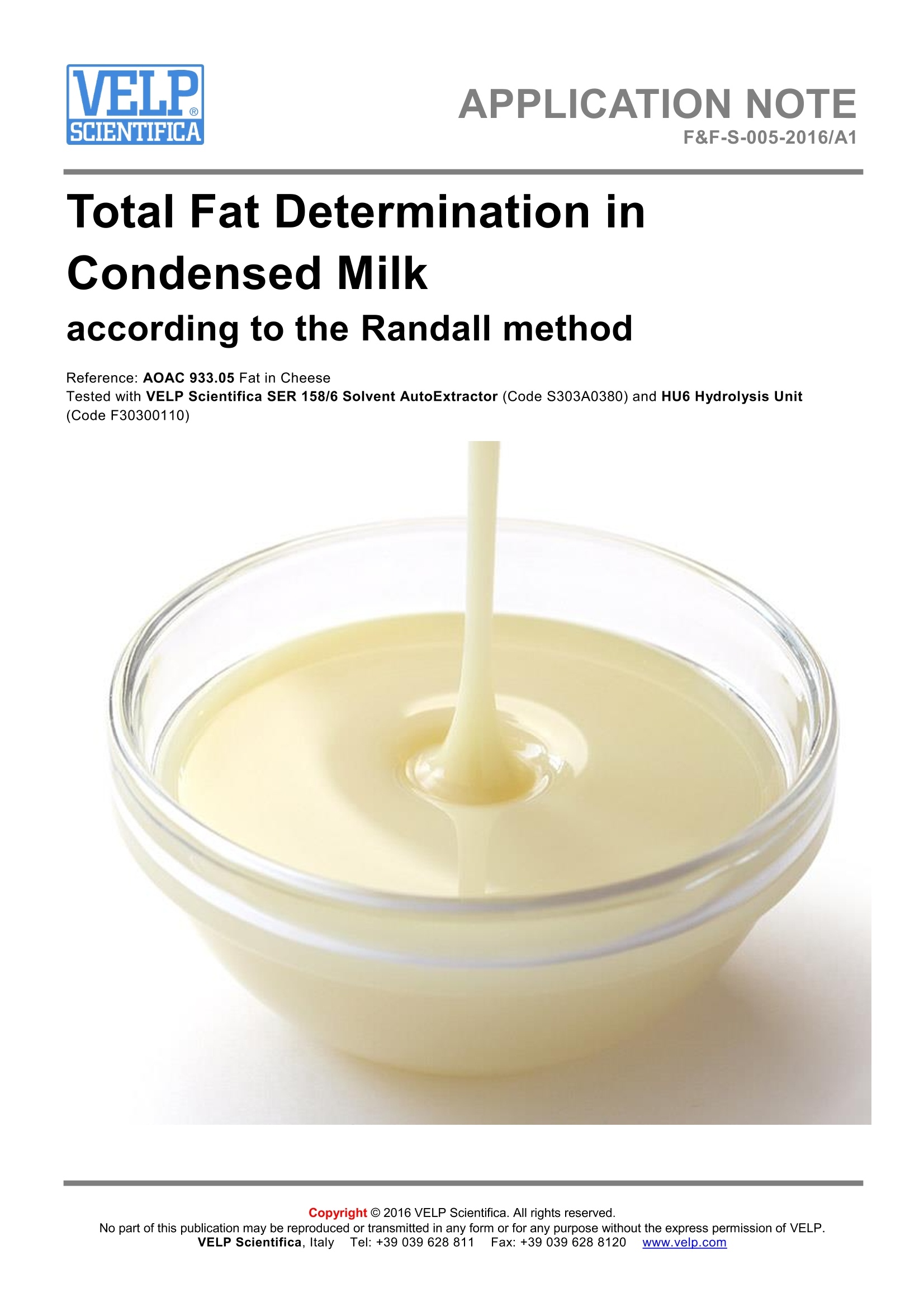
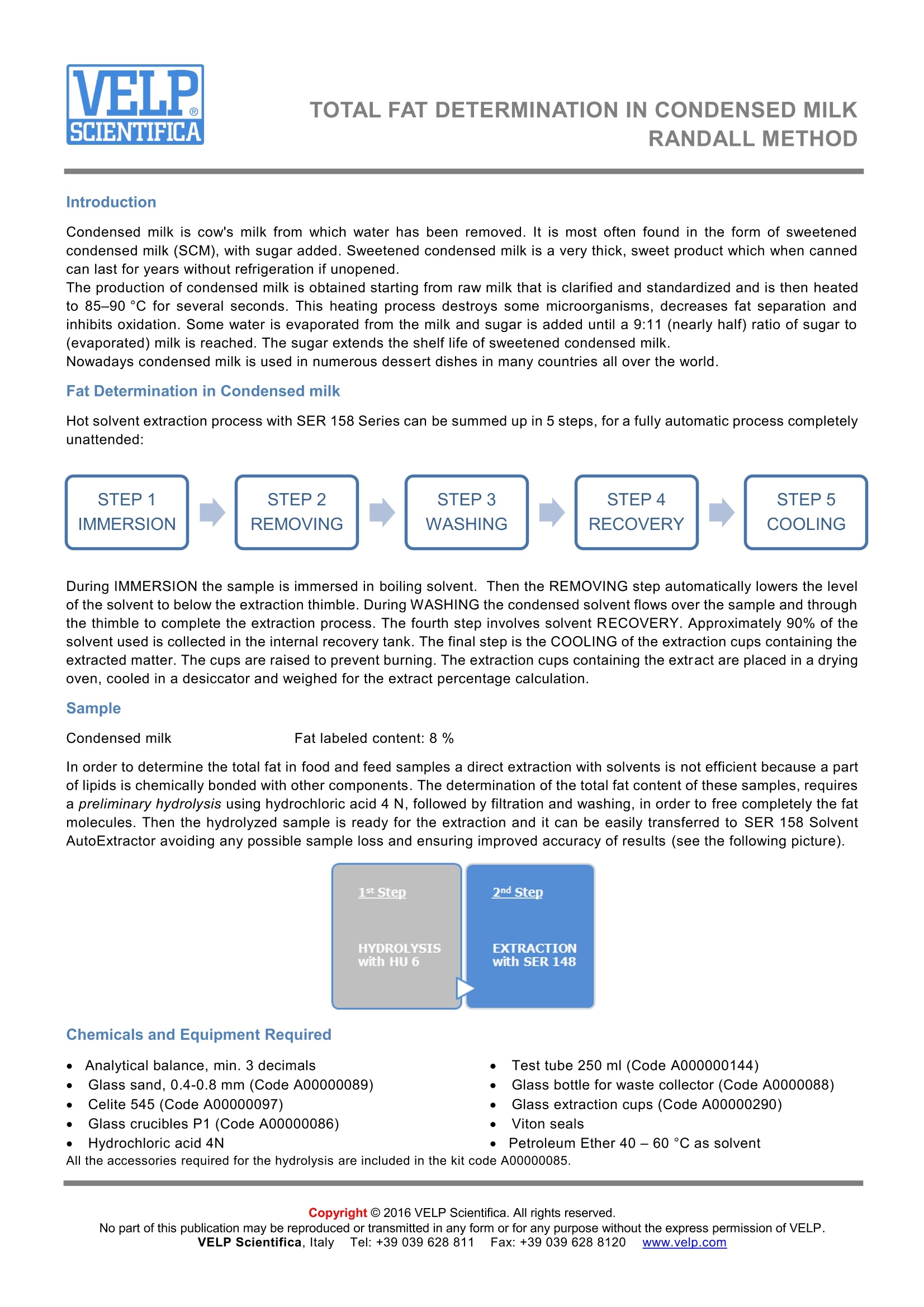
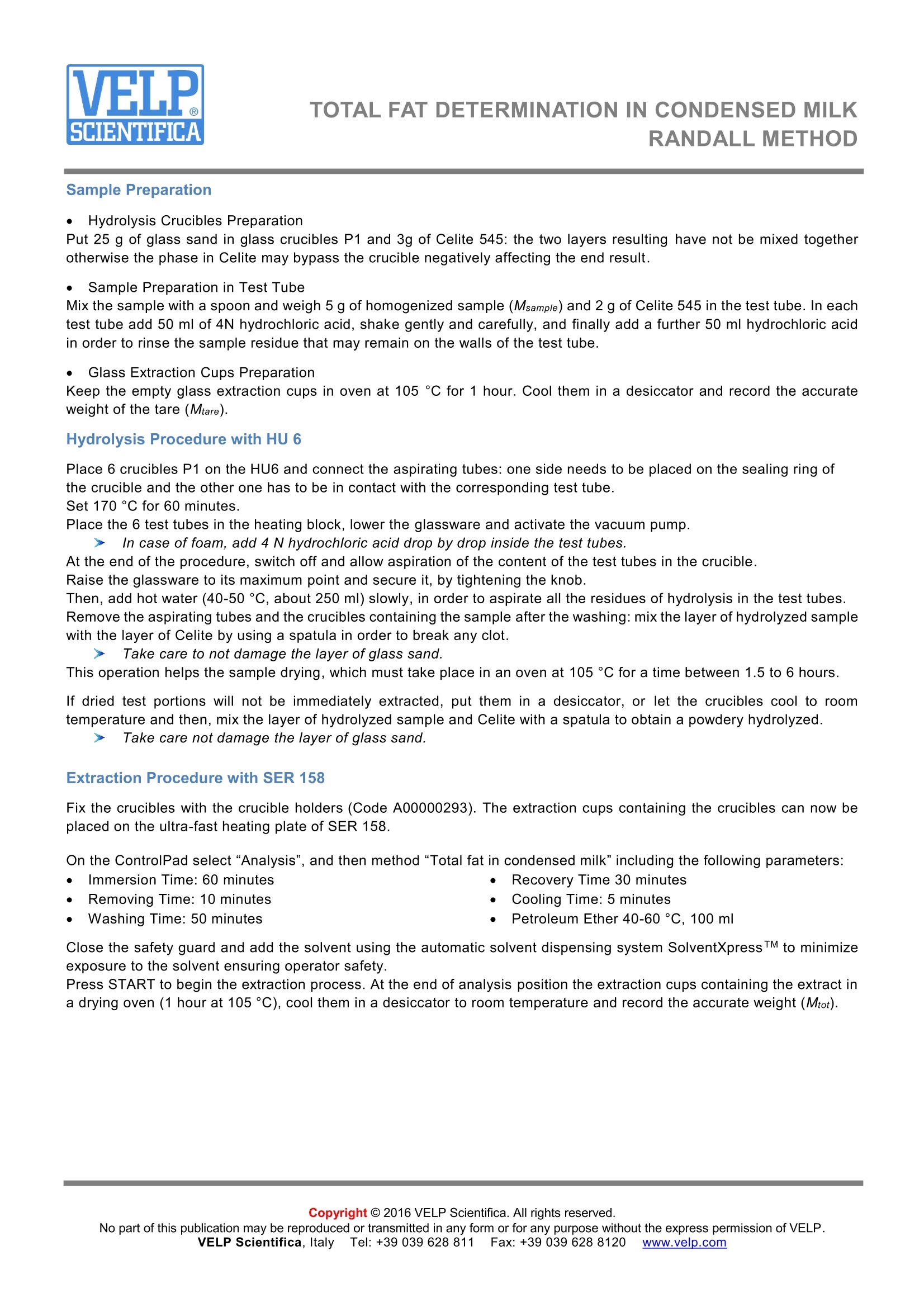
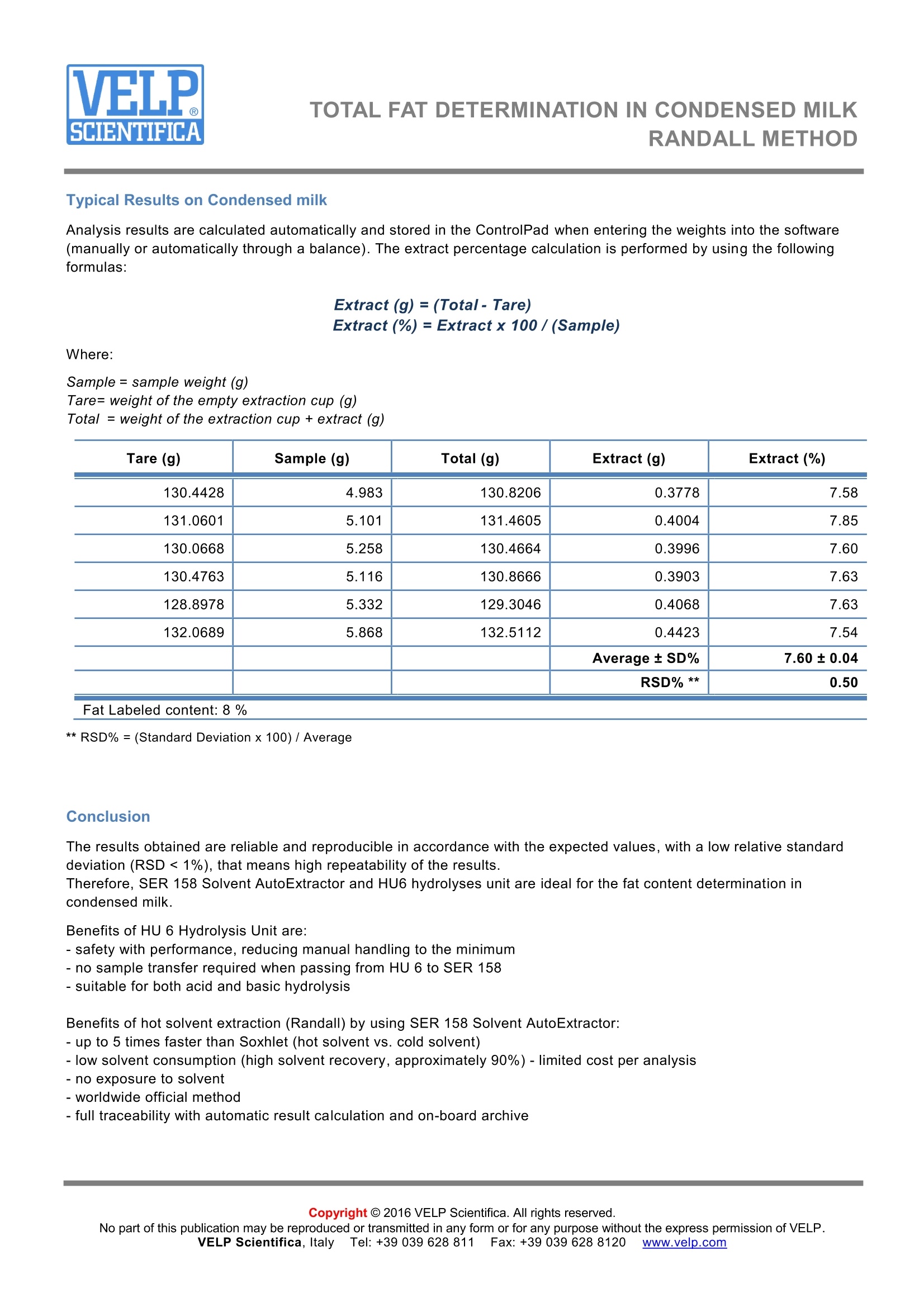
还剩2页未读,是否继续阅读?
意大利VELP公司为您提供《炼乳中总脂肪检测方案(抽提萃取)》,该方案主要用于其他乳制品中营养成分检测,参考标准--,《炼乳中总脂肪检测方案(抽提萃取)》用到的仪器有VELP SER 158 全自动脂肪测定仪(索式抽提仪)
推荐专场
相关方案
更多
该厂商其他方案
更多









